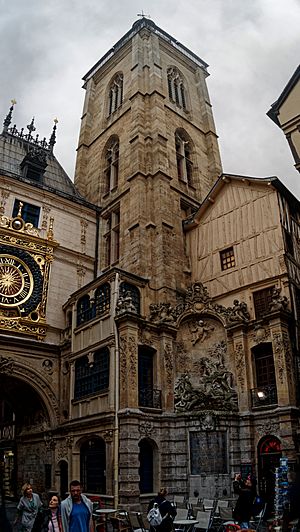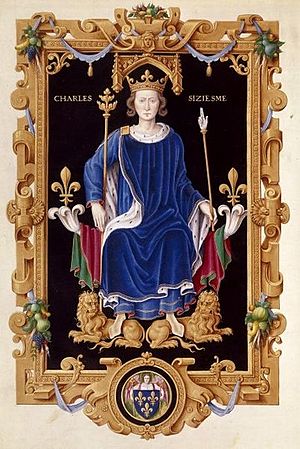Harelle facts for kids
The Harelle was a big protest that happened in the French city of Rouen in 1382. It was followed by another uprising called the Maillotins in Paris a few days later, and many other revolts across France. France was in the middle of the Hundred Years' War, which meant years of fighting, destruction, high taxes, and a struggling economy. The Black Death also made things worse. Rouen, being the second-largest city, felt these problems very strongly.
Tensions had been growing for almost a year since King Charles V died. Before he died, he had gotten rid of many war taxes. But when these taxes were brought back months later, people in Rouen, led by their guilds (groups of skilled workers), started a local revolt. King Charles VI and his uncle, Philip the Bold, Duke of Burgundy, who was acting as his regent (someone who rules for a young king), traveled with an army from Paris. Paris itself revolted shortly after the army left. After dealing with the rebels in Paris, the Duke and King went to Rouen. The leaders of the Harelle in Rouen were afraid of being executed, so they decided not to fight the army. Twelve leaders were executed, the city lost its special rights, a royal governor took control, and the city had to pay a huge fine of 100,000 francs. Even though the King won, he couldn't bring back the taxes that caused the revolt. He spent the next two years putting down similar tax revolts across the kingdom that followed Rouen's example. The Harelle was one of many popular revolts in late medieval Europe, like the English peasants' revolt of 1381 a year before, all part of a larger difficult time in the Late Middle Ages.
Why the Revolt Happened
King Charles V of France died in 1380. Before he passed away, he canceled all royal taxes. He did this to prepare his soul for the afterlife. France was fighting the Hundred Years War against England. The country needed these royal taxes to pay for the war. When the taxes were canceled, the war effort stopped for a while.
Things were also complicated because Charles's son, Charles VI, was too young to rule. His three uncles, the Dukes of Burgundy, Berry, and Anjou, ruled for him. The plague and the war had badly damaged the country. Heavy taxes made many people very poor. Cities were especially affected as people moved there for safety. England also had money problems, and high taxes led to their own Peasants' Revolt in 1381.
By 1382, the uncles agreed on how to run the country. Philip, Duke of Burgundy, was in charge of the government. He tried several times to get new taxes approved by local councils. When that failed, he decided to bring back two old taxes: the gabelle, a sales tax on salt, and the aides, which were customs duties. Representatives from Paris were called to meet the King on January 16. They were pressured to agree to the new tax. They agreed under pressure, but the news spread slowly. The Duke then hired tax farmers, people who collected taxes for the king, which was common back then.
The Rouen Uprising

The first violence over the new taxes happened in Rouen. It was the second-largest city in France. On February 24, a group of men, led by a cloth seller named Jean le Gras, started ringing the city's big bells. Another group closed the city gates. Soon, a large crowd filled the streets. The crowd first targeted rich people, city officials, churches, and tax collectors. Few people were killed, but there was a lot of destruction. The crowd looted every major building. As the day went on, the leaders directed the attack against any building that held public records. All records about rents, lawsuits, debts, and special rights were destroyed.
A group from the city also attacked the nearby Abbey of St. Ouen. They destroyed the gallows (where criminals were hanged) and went into the abbey to find the city's charter. This charter was a document that gave the city special rights. It had been given to Rouen by King Louis X after a similar rebellion in 1315. The abbot (head of the abbey) escaped to a nearby castle. But a large part of the abbey was destroyed. The charter was put on a large pole and paraded around the city. It gave citizens many rights, but it was rarely followed in normal times. The city's leaders were rounded up and forced to promise to follow the charter. The riots lasted for three days. The Archbishop of Rouen, William V de Lestranges, who had feudal rights (special powers) over the city, was captured. He was forced to give up his claims to the city.
The Duke of Burgundy gathered a small army from around Paris. He set out for Rouen with Charles VI and other important officials. After being away for only two days, they heard that a much more violent revolt had started in Paris. They quickly turned the army around to go back to the capital.
The Paris Uprising
On March 3, tax collectors started collecting the new tax in Paris. Violence began in the market of Les Halles. About five hundred men attacked the collectors' booths. Several collectors were beaten to death. The crowd quickly grew to thousands. They attacked the Place de Grève looking for weapons. They found a large store of iron mallets (heavy hammers). Because of these mallets, Jean Froissart called their revolt the "maillotins" (meaning "mallet-wielders").
The newly armed crowd spread across the city. They attacked buildings where they thought valuable things were kept. Churches, businesses, homes of the wealthy, and government buildings were all looted. The Duke of Anjou's large house was taken over and used as a headquarters. The crowd started attacking rich people, government officials, business owners, and moneylenders, beating them to death. The riot became very violent. The Jewish part of the city was attacked. Hundreds of Jewish people were killed.
The city's royal captain, Maurise de Treseguidy, led his small group of soldiers to try and stop the violence. But the crowd quickly put chains across the streets. They began to attack the soldiers, who had to run away. The city government and most royal officials fled. They met with the King and the returning army. Any soldiers who remained held onto the Grand Châtelet, a strong royal building in the city.
When the King arrived at the gates of Paris on March 5, the Duke of Burgundy talked with the crowd's leaders from the city walls. They offered to surrender and let the King back into the city if he met three conditions: cancel all royal taxes, release certain people the Duke had imprisoned, and forgive everyone involved in the Paris revolt. The Duke said the King would release the prisoners, but not meet their other demands. New violence immediately broke out in the city. The crowd attacked the Chatelet and killed several soldiers who couldn't escape. The city's prisons were opened, and everyone was released. However, during the night, the crowd faded away. Leaders of the city's guilds took control. They also refused to open the gates and offered to talk with the King. The King and his army took positions overlooking the city. They stopped river traffic, cutting off the city's main food supply. The Duke of Burgundy called for a large army from his lands. The Dukes of Brittany and Anjou also sent forces to help stop the rebellion.
Ending the Revolts
News of the revolts in Rouen and Paris spread across France. Many other places followed their example. Cities like Amiens, Dieppe, Falaise, Caen, Orléans, and Rheims were taken over by rebels. They followed the pattern of Rouen and Paris: cities were looted, the wealthy were targeted, Jewish people were attacked, and public records were destroyed. More revolts happened in southern France. The Estates of Languedoc, who were meeting to consider a new tax, broke up without approving it. Phoebus Gaston, Count of Foix, refused to accept the Duke of Berry's rule over southern France. He raised an army and set up his own government after taking Toulouse.
Only the mostly independent areas of Provence, Brittany, and Burgundy, where the King's government couldn't collect taxes, avoided a revolt. Tax collection became impossible. This made it very hard to raise a large army to deal with the rebellions. So, the royal council had to make a deal. The King agreed to cancel the taxes and offered to forgive everyone involved. But they had to agree to mediation (a way to settle disagreements). After getting back into Paris, the leaders of the Paris revolt were rounded up and executed.
With Paris back under control, the King and the Duke took the army and again went to Rouen. The city did not fight back. They opened the gates when the King arrived on March 29. Their leaders feared execution, but most were spared. Only twelve leaders of the revolt were executed. The city's bells were taken away, the city gates were symbolically torn down, and a 100,000 franc fine was imposed. The city's special charter was canceled, and Rouen was put under the rule of a royal governor.
The government could not bring back the taxes needed for the war right away. A lot of effort was needed to regain control in all the cities where revolts had happened. The King refused to call a meeting of the Estates General (a national assembly). But many local councils were called to meet in Compiègne. There, small tax agreements were made to partly fund the war. Over the next year, the Duke of Burgundy made a plan to strengthen the government. He gradually arrested and executed those who opposed them. It wasn't until 1387 that the tax issue was finally settled, in the King's favor. The lack of government money forced the government to negotiate the Truce of Leulinghem. This was a long peace agreement lasting several years with the English while they tried to get their power back.
|


